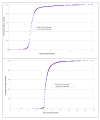Feasibility and impact of providing feedback to vaccinating medical clinics: evaluating a public health intervention
- PMID: 21129216
- PMCID: PMC3017028
- DOI: 10.1186/1471-2458-10-750
Feasibility and impact of providing feedback to vaccinating medical clinics: evaluating a public health intervention
Abstract
Background: Vaccine coverage (VC) at a given age is a widely-used indicator for measuring the performance of vaccination programs. However, there is increasing data suggesting that measuring delays in administering vaccines complements the measure of VC. Providing feedback to vaccinators is recognized as an effective strategy for improving vaccine coverage, but its implementation has not been widely documented in Canada. The objective of this study was to evaluate the feasibility of providing personalized feedback to vaccinators and its impact on vaccination delays (VD).
Methods: In April and May 2008, a one-hour personalized feedback session was provided to health professionals in vaccinating medical clinics in the Quebec City region. VD for vaccines administered at two and twelve months of age were presented. Data from the regional vaccination registry were analysed for participating clinics. Two 12-month periods before and after the intervention were compared, namely from April 1st, 2007 to March 31st, 2008 and from June 1st, 2008 to May 31st, 2009.
Results: Ten medical clinics out of the twelve approached (83%), representing more than 2500 vaccinated children, participated in the project. Preparing and conducting the feedback involved 20 hours of work and expenses of $1000 per clinic. Based on a delay of one month, 94% of first doses of DTaP-Polio-Hib and 77% of meningococcal vaccine doses respected the vaccination schedule both before and after the intervention. Following the feedback, respect of the vaccination schedule increased for vaccines planned at 12 months for the four clinics that had modified their vaccination practices related to multiple injections (depending on the clinic, VD decreased by 24.4%, 32.0%, 40.2% and 44.6% respectively, p < 0.001 for all comparisons).
Conclusions: The present study shows that it is feasible to provide personalized feedback to vaccinating clinics. While it may have encouraged positive changes in practice concerning multiple injections, this intervention on its own did not impact vaccination delays of the clinics visited. It is possible that feedback integrated into other types of effective interventions and sustained over time may have more impact on VD.
Figures
Similar articles
-
Vaccination practices, policies, and management factors associated with high vaccination coverage levels in Georgia public clinics. Georgia Immunization Program Evaluation Team.Arch Pediatr Adolesc Med. 2000 Feb;154(2):184-9. doi: 10.1001/archpedi.154.2.184. Arch Pediatr Adolesc Med. 2000. PMID: 10665607
-
Impact of vaccine delays at the 2, 4, 6 and 12 month visits on incomplete vaccination status by 24 months of age in Quebec, Canada.BMC Public Health. 2018 Dec 11;18(1):1364. doi: 10.1186/s12889-018-6235-6. BMC Public Health. 2018. PMID: 30537969 Free PMC article.
-
How are children who are delayed in the Childhood Vaccination Programme vaccinated: A nationwide register-based cohort study of Danish children aged 15-24 months and semi-structured interviews with vaccination providers.Scand J Public Health. 2020 Feb;48(1):96-105. doi: 10.1177/1403494818786146. Epub 2018 Jul 19. Scand J Public Health. 2020. PMID: 30024308
-
Immunization coverage levels among 19- to 35-month-old children in 4 diverse, medically underserved areas of the United States.Pediatrics. 2004 Apr;113(4):e296-302. doi: 10.1542/peds.113.4.e296. Pediatrics. 2004. PMID: 15060256
-
Effect of a multi-modal intervention on immunization rates in obstetrics and gynecology clinics.Am J Obstet Gynecol. 2016 May;214(5):617.e1-7. doi: 10.1016/j.ajog.2015.11.018. Epub 2015 Nov 25. Am J Obstet Gynecol. 2016. PMID: 26627727
Cited by
-
Countering vaccine hesitancy through immunization information systems, a narrative review.Hum Vaccin Immunother. 2019;15(11):2508-2526. doi: 10.1080/21645515.2019.1599675. Epub 2019 Jun 21. Hum Vaccin Immunother. 2019. PMID: 30932725 Free PMC article. Review.
-
Interventions to increase pediatric vaccine uptake: An overview of recent findings.Hum Vaccin Immunother. 2017 Nov 2;13(11):2503-2511. doi: 10.1080/21645515.2017.1367069. Epub 2017 Sep 26. Hum Vaccin Immunother. 2017. PMID: 28949819 Free PMC article. Review.
-
The psychenet public health intervention for anorexia nervosa: a pre-post-evaluation study in a female patient sample.Prim Health Care Res Dev. 2018 Jan;19(1):42-52. doi: 10.1017/S1463423617000524. Epub 2017 Aug 22. Prim Health Care Res Dev. 2018. PMID: 28829284 Free PMC article.
-
Increasing Coverage of Appropriate Vaccinations: A Community Guide Systematic Economic Review.Am J Prev Med. 2016 Jun;50(6):797-808. doi: 10.1016/j.amepre.2015.11.003. Epub 2016 Feb 1. Am J Prev Med. 2016. PMID: 26847663 Free PMC article.
References
-
- Bos E, Batson A. Using immunization coverage rates for monitoring health sector performance: Measurement and interpretation issues. Washington DC: Human development network, The World Bank; 2000. pp. 1–21.
-
- Comité consultatif national sur l'immunisation (Ed.) Guide canadien d'immunisation. 7. Ottawa: Agence de la santé publique du Canada; 2006. p. 410.
-
- Boulianne N, Bradet R, Audet D, Deceuninck G. Enquête sur la couverture vaccinale des enfants de 1 an et 2 ans au Québec en 2008. Québec: Institut national de santé publique du Québec; 2009. pp. 1–205.
Publication types
MeSH terms
LinkOut - more resources
Full Text Sources
Medical
Miscellaneous



